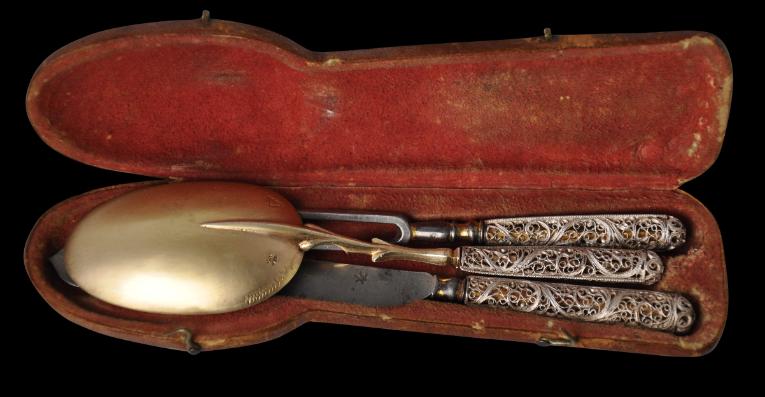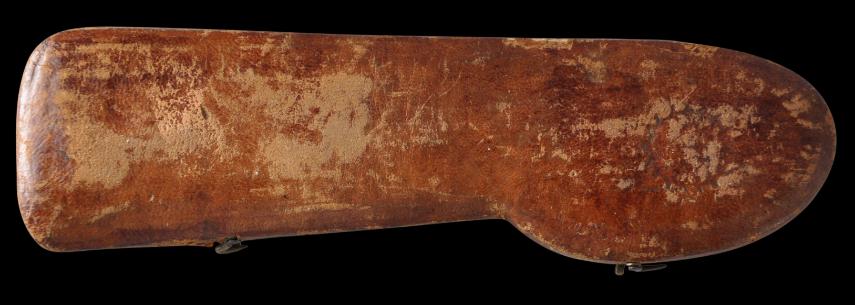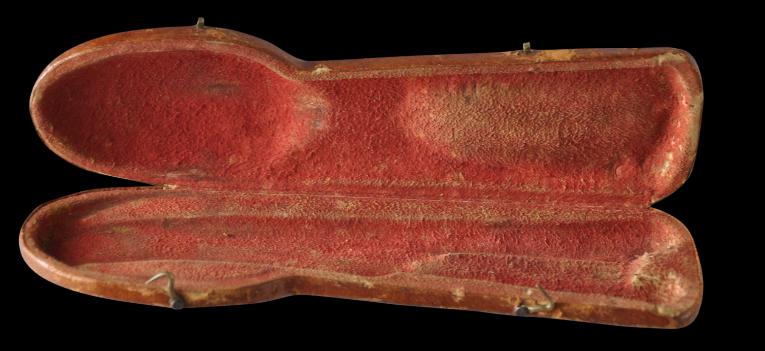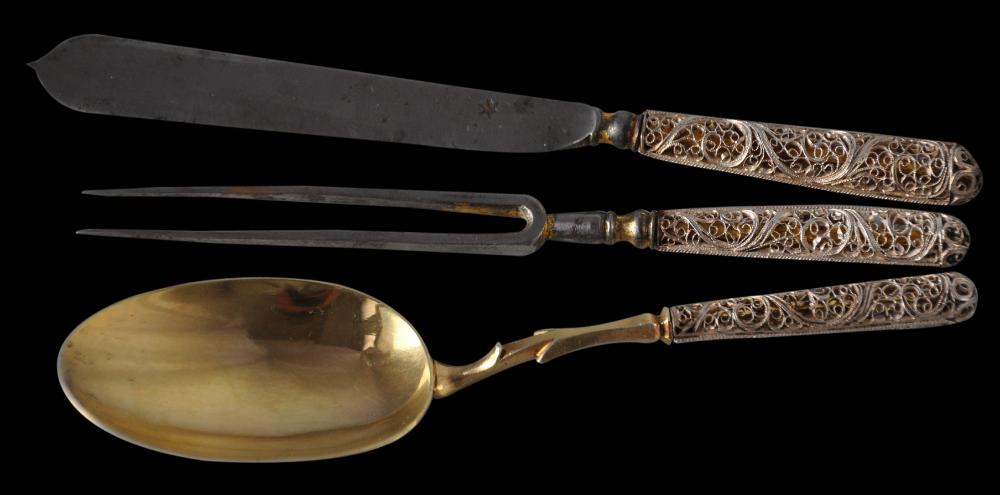
Filigree Eating Set, 17th century
Traveller’s Silver Gilt Filigree Cutlery Set & Leather Case
Augsburg, Germany or India
mid-17th century
length of utensils: 14cm-15.5cm; combined weight of utensils: 54g; length of leather case: 16.6cm
This set comprises a hand-tooled leather and a rat-tail spoon, a two-tined fork, and a knife.
The handles of each utensil comprises a gilded silver shaft with an outer layer of silver filigree work arrayed in foliate swirls. The spoon’s bowl and stem are gilded, and the knige blade and fork’s tines show signs of having been gilded.
The bowl of the spoon has a zig-zag assay mark, a mark that appears to be the city mark for Augsburg, and what appears to be a maker’s mark in the shape of a jug.
The case is kept closed with two small brass latches, both of which are still present and function well. The exterior of the case has traces of gilding and the remnants of impressed design work that appears to include the staff or caduceus of Mercury, the Roman patron god of commerce and travellers. The caduceus, incidentally, was also one of the symbols of the Dutch East Indies Company (VOC).
Sets like these were produced in Augsburg in the seventeenth century, and certainly the spoon of this set has city marks for Augsburg for the seventeenth and early eighteenth century. They were produced for travellers. European merchants and administrators travelling to the East would have taken their own sets with them given the absence of European eating utensils in their destinations.
In any event, forks were only starting to be used widely by the European aristocracy around the early seventeenth century. The earliest fork to bear and English hallmark dates to 1632. Around this time, it became customary to make knife, spoon and fork sets. Better quality sets were contained in a custom-made leather case. Only very wealthy households would provide cutlery for their guests, otherwise they would be expected to bring their own or eat without the aid of cutlery. Similarly, inns were not equipped with tableware. Travellers were expected to carry their own – hence the need for cased, portable sets.
Forks initially had only two tines, as with the example here. The case-hardened steel used to make the tines tended to wear down quickly and so they were made long and very pointed and sharp. But the two-pronged fork was impractical for eating certain small foods such as peas and grains, and so forks were made with three and four tines towards the end of the seventeenth century. They also started to be made with more of a curve instead of having tines that were rigidly flat as is the case with the fork here.
Most such sets appear to have been produced in Augsburg, Germany. However, it seems very likely that such sets were copied in India and probably Batavia and perhaps even Malacca. Indeed, this set was apparently acquired by the family that previously owned it from a relative who bought it in India and presented as a Christeneing set in respect of a newborn family member who was born in 1890. The set seems to be of Augsburg manufacture, but there is the possibility that it was made in India, perhaps Gujarat, and that the Augsburg city marks are apocryphal.
Castilho (2010, p. 98) illustrates a knife and fork (with three tines) with similar filigree work about the handles which he argues is from India, at least in part.
The set is in fine condition with only a few losses to the filigree. Such sets that retain their original fitted cases are relatively rare, as are sets that have forks with two rather than three tines, suggesting that they are among the earliest of such sets.
References
Castilho, M., ‘Oriente – Ocidente 2’, Lisbon, 2010.
Harrison, M., The Kitchen in History, Charles Scribner, 1972.
Provenance
UK art market
Inventory no.: 1930
SOLD









